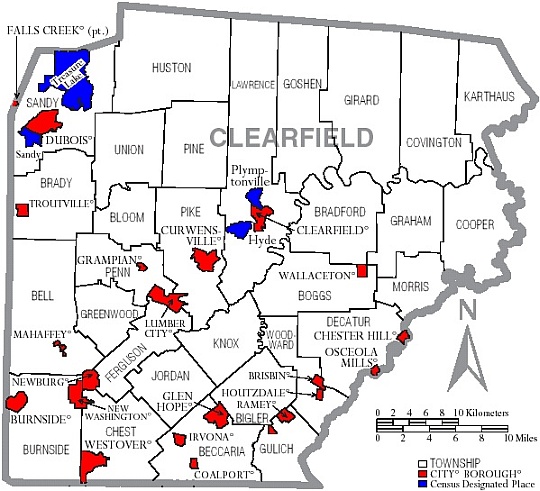|
Other Useful Clearfield Co. Links
|
History of Clearfield County
Formed on March 26, 1804, from parts of Huntingdon and Lycoming Counties, and named for Clearfield Creek. The name alluded to openings or deer fields in its vicinity. For many years Clearfield County functioned as part of Centre County, not electing its own commissioners until 1812. It was organized for judicial purposes in 1822. Clearfield, the county seat, was incorporated as a borough on April 21, 1840.
The first settlement was Capt. Edward Rickert’s in 1784, on the site of Coalport. The Erie Pike, which ran from Milesburg, Centre County, to Erie County, opened up Clearfield after 1804. The production of logs and cut lumber dominated the economy until 1910, and these, especially white pine and hemlock, were floated down the West Branch of the Susquehanna from 1837 to 1917. In 1920 the population reached 103,236, its all time peak. In 1871 lumber king John Dubois Jr. opened up the northwest of the county with ventures that included a box factory, iron mill, and tannery, but by 1900 all the trees on the Dubois family lands had gone. The McCrory’s chain of five-and-dime stores began in the town of Dubois. Low sulfur bituminous coal was mined all over the county until the peak year of 1918. This is still the state’s fourth largest bituminous producer; nearly all the coal now comes from strip mines. There is a strong United Mine Workers tradition. Railroads arrived, reaching the county seat, Clearfield, in 1879 and Dubois in 1874. The New York Central and the Buffalo, Rochester, and Pittsburgh Railroads connected with the county to obtain coal, and railroad maintenance shops arose in Dubois. Firebricks and construction bricks are manufactured. In recent decades light metal manufacturing and printing have been mainstays of the economy. The periods of lumbering and mining brought in large numbers of European immigrants, many of whose descendants have remained. There were Underground Railroad stations at Grampian Hills and Burnside Township. Gov. William Bigler started a newspaper in Clearfield and represented the county in the State Senate. Five-and-dime merchant John J. McCrory and musical composers Philip Paul Bliss and George Rosencranz came from this county. Only 8 ½ percent of the area is farmed, and Clearfield ranks between 55th and 60th in cash receipts from agriculture.
Source: Pennsylvania Historical and Museum Commission (PHMC)

Map of Clearfield County, Pennsylvania, United States with township and municipal boundaries is taken from US Census website and modified by Ruhrfisch in April 2006.
Previous County (Clarion) || Next County (Clinton)  Pennsylvania List of Counties Pennsylvania List of Counties
Check out the entireTIME VOYAGERS BOOKSTORE for general titles in genealogy, history, or general best sellers.
|



 Pennsylvania List of Counties
Pennsylvania List of Counties Return to Time Voyagers home page
Return to Time Voyagers home page